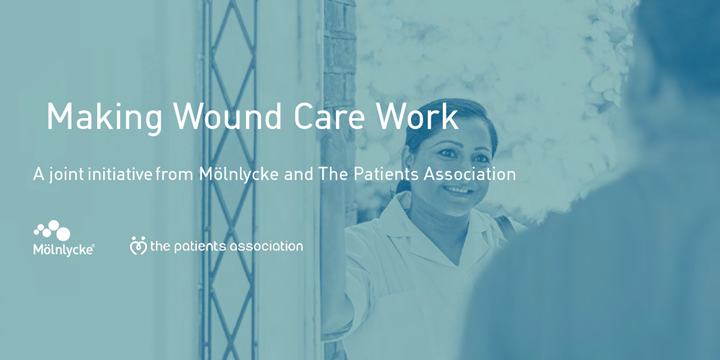Making Wound Care Work

Making Wound Care Work calls for a collaborative approach between nurses and patients to rebuild wound care post-pandemic and support the 3.8 million people living with a chronic wound– that’s equivalent to 7% of the UK population.1
In 2022, in partnership with The Patients Association, we published the in-depth Making Wound Care Work report that summarised the wound care landscape and raised a number of questions as we look ahead to rebuilding wound care services following the pandemic. Since the publication of the report we have worked with healthcare professionals and patients, via the Patients Association, to develop key recommendations to improve the quality of care for patients with wounds.

Our pledge of support:
We believe we must act now to fully support the 3.8 million people living with a wound in the UK and to reduce the billions that wound care costs the NHS each year.Wound care needs to be prioritised, and wound care services redesigned to put people first.
Right care, right place, right time: Making Wound Care Work recommendations
Following the publication of Making Wound Care Work (2022), Mölnlycke have consulted with wound care nurses and patients about the questions raised in the report, and what recommendations for action could look like. The overwhelming theme that came from both sessions, is that there needs to be a renewed focus on the right care, at the right place, at the right time.
Chronic wounds are not treated as a condition in themselves; rather, they are often seen as a symptom or complication of other conditions, such as diabetes. This means that they are not a consultant led service, like most other areas of medical specialty, and often those involved in delivering wound care, in either community or other specialisms, have not received sufficient training in wound care.
There is a clear need for a focus on prevention and treatment for chronic wounds, and in addition, more work needs to be done to involve patients in their care. This would allow both patients and the clinical team to work together to determine the right treatment and, where appropriate, the right level of supported self-care, as part of a shared decision making approach.
These six recommendations reflect the views of healthcare professionals involved in wound care, and patients and carers living with a wound. They call for changes to wound care provision aimed at improving outcomes and promoting the right care, at the right place, at the right time.
- Upskilling generalist healthcare staff on wound care
Non wound care specialists need more training in wound care
- One of the primary concerns of both nurses and patients was the lack of specialist wound care knowledge in community care settings, and among non-specialist staff, such as staff nurses and community nurses.
- For example, a survey of pre-registration nursing students found 68% reported that they had received fewer than 10 hours’ formal teaching on skin integrity over their 3-year course.2
- To help alleviate the wound care skills gap, we recommend the implementation of a more accessible programme to upskill these staff to gain a better understanding of, and expertise in, wound care, wound healing stages, the appropriate pathways for patients with chronic wounds, effective treatment and management of wounds, the right time to refer, and how to manage wounds to get better outcomes for patients.
- All of this requires prioritisation by the senior leadership team to allow non-specialists the protected time for learning.
2. Shared decision-making
There should be a greater focus on shared decision making in wound care
- Patients should have a greater voice in their care, to help avoid the kind of frustration that they often feel; and clinicians should operate a shared decision-making model in wound care. Patients with chronic wounds can sometimes feel like experts by experience, they also have diverse needs depending on the nature of their wound and how it is impacting their quality of life.
- Equally, patients need to be supported in understanding the nature of their wound, and provided with information to help optimise wound healing, helping them to become experts in their own care, together with their clinical team.
3. Maintained support in supported self-care
The role – and application – of supported self-care needs to be carefully considered as part of the treatment mix available for wound care
- There has been a rise in supported self-care throughout the COVID-19 pandemic, but as the health service has opened back up, levels of supported self-care have varied.
- It should be acknowledged that supported self-care is not the preferred or best option for all patients.
- There should be a discussion between the patient and the clinical team to understand the best approach, thereby providing the best chance of a positive outcome.
- For those patients who choose supported self-care, consistent standards should be set across the country to reduce variation in outcomes and empower patients.
4. Joined-up service across community and secondary care to allow for the adoption of existing care pathways for improved outcomes
There needs to be a coherent wound care service delivered across different NHS settings and teams
- One of the reasons wound care outcomes vary so much is that chronic wounds are often managed as part of wider care for another condition. This can lead to them not receiving the specialist attention they need.
- We need a specific and dedicated wound care patient flow between care settings, to build upon existing pathways and work from diagnosis to healing. A flow that details specific interventions for those living with a chronic wound to help guide non-specialist staff working with patients in other disciplines, providing clarity on when greater intervention on wound management is necessary.
- Methods such as wound care passports (to aid continuity of care), and wound care specialists’ involvement in the MDT from the outset could further increase the chances of identifying complications earlier helping to ensure patients get the right care at the right time.
5. Improved data collection
A wound care registry or similar should be created to standardise the measurement of wound care outcomes across England :
- A wound care registry or similar should be created to standardise the measurement of wound care outcomes across the country – such a facility has been created in Wales, and has around 19,000 entries, which is helping to inform clinical practice, as well as support research in the subject.[1]
- In addition to recording and monitoring healing rates, this should include data on treatments and dressings, to ensure that clinicians can understand what interventions work well.
- Patient centric measurements, such as Patient Reported Outcomes Measures (PROMs) and quality of life questionnaires should also be included.
- Health leaders should consider opening this data to industry to aid innovation in wound care across both product and digital solutions.
- Including this data requirement, or further wound care measurement/outcomes, within a CQUIN, QOF points, or some other form of incentivisation, would help to elevate the attention wound care receives.
[1] Welsh Wound Innovation Centre (2017) Annual Report 2017 – found at https://www.wwic.wales/uploads/files/documents/Publications/Annual%20Report%202016.pdf - accessed 11/10/2022
6. Improved public health messaging
Public health messaging to educate people about the importance of wound care
- Improved public health messaging, targeted at addressing health issues that can cause and/or make wounds worse. With proper intervention, much more can be done to improve wound healing, and so spotting difficulties earlier, or even preventing them from happening, can help to reduce complications and alleviate pressures on the healthcare system.
We're working with The Patients Association to change the way wound care works in the NHS and you can help. By downloading this report, and joining us on this journey, you will be making a big impact.
Download the Making Wound Care Report here
If you would like to keep up to date on the Making Wound Care Work campaign, please fill in the form to be added to our mailing list.
If you'd like to show your support for Making Wound Care Work, please click the post below to share:
Read the article in the BJCN here

- Guest, J.F., Fuller, G.W., Vowden, P. 2020. Cohort study evaluating the burden of wounds to the UK’s
National Health Service in 2017/2018: update from 2012/2013. BMJ Open 2020;10:e045253. doi:10.1136/
bmjopen-2020-045253 - Blackburn, J; Ousey, K; Stephenson, J; (2019) Nurses’ Education, Confidence, and Competence in Appropriate Dressing Choice - Advances in Skin & Wound Care. 32(10):470-476 found at https://journals.lww.com/aswcjournal/Abstract/2019/10000/Nurses__Education,_Confidence,_and_Competence_in.6.aspx (accessed 11/10/2022)




